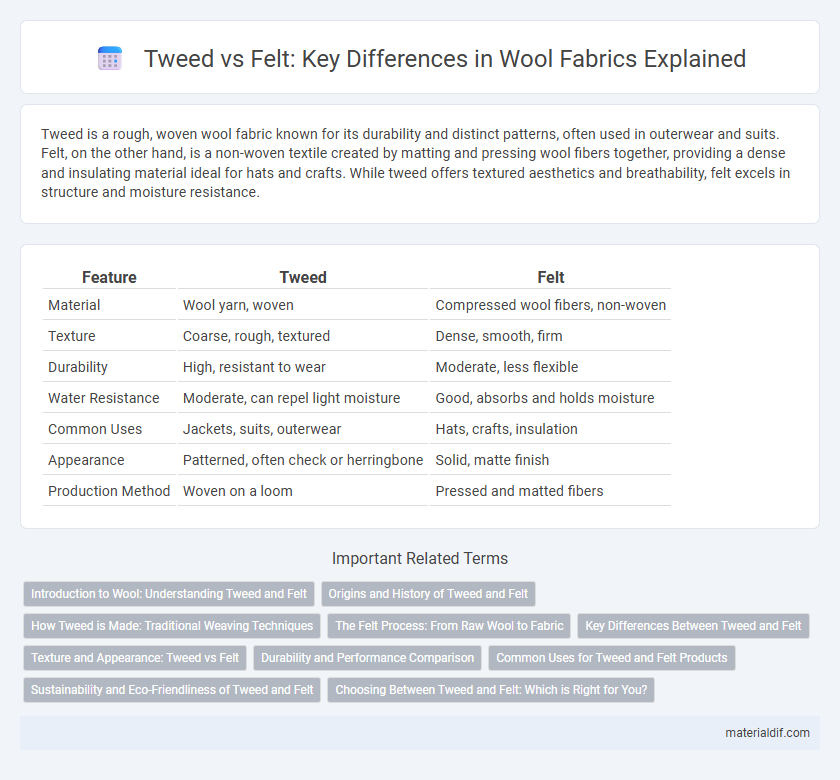Tweed is a rough, woven wool fabric known for its durability and distinct patterns, often used in outerwear and suits. Felt, on the other hand, is a non-woven textile created by matting and pressing wool fibers together, providing a dense and insulating material ideal for hats and crafts. While tweed offers textured aesthetics and breathability, felt excels in structure and moisture resistance.
Table of Comparison
| Feature | Tweed | Felt |
|---|---|---|
| Material | Wool yarn, woven | Compressed wool fibers, non-woven |
| Texture | Coarse, rough, textured | Dense, smooth, firm |
| Durability | High, resistant to wear | Moderate, less flexible |
| Water Resistance | Moderate, can repel light moisture | Good, absorbs and holds moisture |
| Common Uses | Jackets, suits, outerwear | Hats, crafts, insulation |
| Appearance | Patterned, often check or herringbone | Solid, matte finish |
| Production Method | Woven on a loom | Pressed and matted fibers |
Introduction to Wool: Understanding Tweed and Felt
Tweed and felt represent two distinct wool textiles, each with unique production methods and applications. Tweed is a woven fabric characterized by its rough texture and patterned appearance, commonly used in jackets and suits for its durability and classic style. Felt, made by matting and compressing wool fibers without weaving, offers a dense, insulating material ideal for crafts, hats, and industrial uses.
Origins and History of Tweed and Felt
Tweed originated in Scotland and Ireland during the 18th century, known for its rough, woven woolen texture ideal for outdoor wear in damp climates. Felt, one of the oldest textiles dating back to prehistoric times, is created by matting, condensing, and pressing wool fibers together, widely used across Central Asia and Northern Europe for clothing and shelter. Historical use of tweed was closely linked to aristocratic hunting and farming, while felt played a crucial role in nomadic cultures due to its insulation and durability.
How Tweed is Made: Traditional Weaving Techniques
Tweed is made using traditional weaving techniques that involve tightly weaving wool fibers on a loom, creating a durable and textured fabric renowned for its rough surface and intricate patterns. The wool used in tweed is often carded and spun into yarn before weaving, enhancing its resilience and warmth. Unlike felt, which is produced by matting and compressing wool fibers together, tweed's construction relies on precise interlacing of yarns to form a strong, breathable textile ideal for outdoor wear.
The Felt Process: From Raw Wool to Fabric
The felt process begins with raw wool fibers that are first cleaned and carded to align the strands. Moisture, heat, and pressure are then applied to mat and compress the fibers together, creating a dense, non-woven fabric. This method contrasts with tweed production, which involves spinning wool into yarn before weaving it into textured patterns.
Key Differences Between Tweed and Felt
Tweed is a rough, woven wool fabric characterized by its durability and distinctive patterns like herringbone or checks, often used in jackets and suits, while felt is a non-woven textile made by matting and pressing wool fibers, resulting in a dense, smooth surface commonly used for hats and crafts. Tweed's woven structure gives it breathability and texture, contrasting with felt's ability to be molded into shapes due to its compact, interlocked fibers. The key differences lie in their manufacturing processes, textures, and typical applications, with tweed favored for rugged outerwear and felt prized for versatile, shapeable materials.
Texture and Appearance: Tweed vs Felt
Tweed wool features a coarse, rough texture with a distinctive woven pattern, often showcasing specks of multiple colors that create a visually rich, rugged appearance. Felt wool, on the other hand, has a smooth, dense texture achieved through matting and compression, resulting in a uniform, matte surface without visible weave patterns. The tactile contrast between Tweed's textured, grainy feel and Felt's soft, pliable finish influences their use in fashion and upholstery.
Durability and Performance Comparison
Tweed wool features a tightly woven structure that offers exceptional durability and resistance to wear, making it ideal for outerwear exposed to rough conditions. Felt wool, created through matting and pressing fibers, provides superior insulation and water resistance but tends to be less durable under heavy abrasion. The performance comparison highlights tweed's strength and longevity for rugged use, whereas felt excels in warmth and moisture protection in less demanding applications.
Common Uses for Tweed and Felt Products
Tweed is commonly used for durable outdoor clothing like jackets and hats, prized for its moisture resistance and warmth. Felt excels in crafting accessories such as slippers, hats, and decorative items due to its dense, insulating properties. Both materials serve functional fashion purposes, with tweed favored in rugged wear and felt in soft, flexible designs.
Sustainability and Eco-Friendliness of Tweed and Felt
Tweed and felt both offer sustainable wool options, with tweed often produced from natural, undyed fibers that reduce chemical use and minimize environmental impact. Felt's eco-friendliness comes from its dense, non-woven structure that requires less energy and water during manufacturing compared to woven fabrics. Both materials support sustainable fashion by utilizing renewable wool and enabling recyclability, but felt typically boasts a smaller carbon footprint due to its simpler production process.
Choosing Between Tweed and Felt: Which is Right for You?
Tweed and felt offer distinct textures and functionalities, with tweed prized for its durability, breathability, and textured patterns ideal for jackets and suits, while felt provides a smooth, dense fabric perfect for crafts and insulation. Choosing between tweed and felt depends on the intended use, as tweed excels in outdoor wear due to its woolen weave, and felt is favored for its moldability and warmth retention. Consider factors like abrasion resistance, moisture-wicking properties, and aesthetic preferences to determine whether tweed's rugged elegance or felt's soft compactness suits your needs.
Tweed vs Felt Infographic

 materialdif.com
materialdif.com